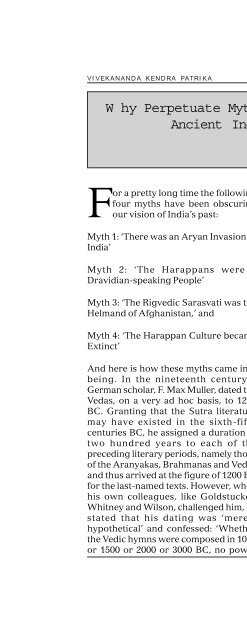Aryan Invasion Theory - Publication - Vivekananda Kendra
Aryan Invasion Theory - Publication - Vivekananda Kendra
Aryan Invasion Theory - Publication - Vivekananda Kendra
You also want an ePaper? Increase the reach of your titles
YUMPU automatically turns print PDFs into web optimized ePapers that Google loves.
VIVEKANANDA KENDRA PATRIKA<br />
For a pretty long time the following<br />
four myths have been obscuring<br />
our vision of India’s past:<br />
Myth 1: ‘There was an <strong>Aryan</strong> <strong>Invasion</strong> of<br />
India’<br />
Myth 2: ‘The Harappans were a<br />
Dravidian-speaking People’<br />
Myth 3: ‘The Rigvedic Sarasvati was the<br />
Helmand of Afghanistan,’ and<br />
Myth 4: ‘The Harappan Culture became<br />
Extinct’<br />
And here is how these myths came into<br />
being. In the nineteenth century a<br />
German scholar, F. Max Muller, dated the<br />
Vedas, on a very ad hoc basis, to 1200<br />
BC. Granting that the Sutra literature<br />
may have existed in the sixth-fifth<br />
centuries BC, he assigned a duration of<br />
two hundred years to each of the<br />
preceding literary periods, namely those<br />
of the Aranyakas, Brahmanas and Vedas<br />
and thus arrived at the figure of 1200 BC<br />
for the last-named texts. However, when<br />
his own colleagues, like Goldstucker,<br />
Whitney and Wilson, challenged him, he<br />
stated that his dating was ‘merely<br />
hypothetical’ and confessed: ‘Whether<br />
the Vedic hymns were composed in 1000<br />
or 1500 or 2000 or 3000 BC, no power<br />
62<br />
ARYAN INVASION THEORY<br />
W hy Perpetuate Myths? A Fresh Look at<br />
Ancient Indian History<br />
B. B. Lal<br />
on earth will ever determine.’ However,<br />
the saddest part of the story is that his<br />
blind followers, both in India and abroad,<br />
even today swear by 1200 BC and do not<br />
dare cross this Laksmana rekha.<br />
Be that as it may. The first quarter of the<br />
twentieth century witnessed the<br />
discovery of an altogether unknown<br />
civilization on the Indian subcontinent,<br />
datable to the third millennium BC.<br />
Called variously the Harappan, Indus or<br />
Indus-Sarasvati Civilization, it is<br />
characterised, amongst other things, by<br />
systematic town-planning, an<br />
underground drainage, excellently<br />
engraved seals, a monumental script, a<br />
refined system of weights and measures<br />
and some beautiful statuary.<br />
However, recent excavations have<br />
thrown new light on various other<br />
aspects of this civilization, which call for<br />
a fresh look at many issues connected<br />
with it. Radiocarbon dates indicate that<br />
its roots go back to the 5th millennium<br />
BC, while its peak period lay between<br />
2600 and 2000 BC, after which began its<br />
decline.<br />
With the discovery of Harappan<br />
Civilization there also started a debate<br />
about its authors. Because of Max<br />
Muller’s fatwa that the Vedas were not

















